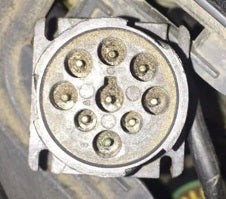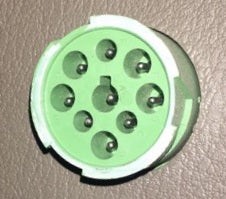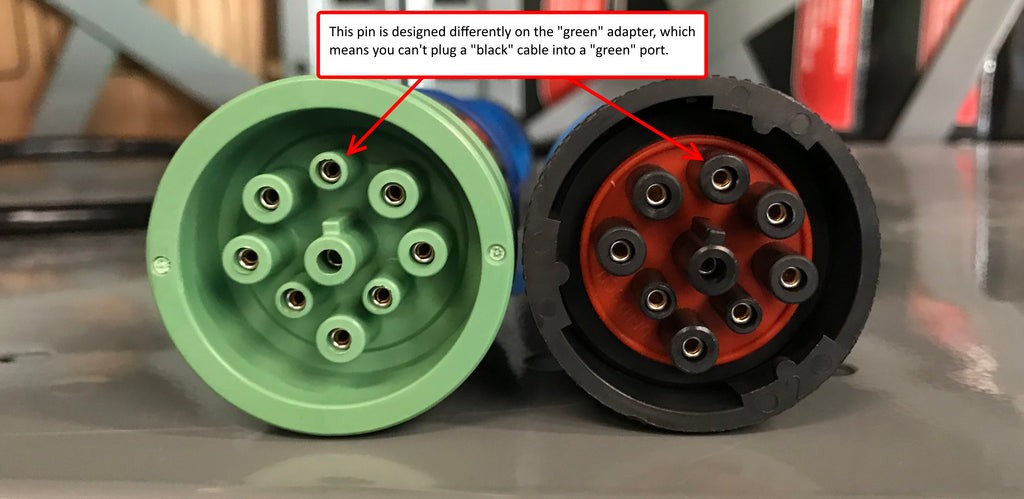The world of commercial vehicle diagnostics took a turn in 2016 when manufacturers began introducing trucks with a new green 9-pin diagnostic port. If you’re an automotive technician familiar with the older black 9-pin connectors, you’ve likely encountered this change and asked questions like: What is this green connector? Why won’t my old cables fit? And what does this mean for my diagnostic tools?
This shift to the green 9-pin, often referred to as a Type II or CAN500 connector, wasn’t just a cosmetic change. It signifies a significant evolution in commercial vehicle network technology, driven by the increasing complexity of modern trucks. Understanding this change, and how it relates to tools like a 9 Pin Jbus To Obd2 Adapter, is crucial for effective diagnostics on newer vehicles.
Let’s delve into the reasons behind this transition, explore the technical differences, and clarify how you can adapt your diagnostic equipment to work seamlessly with these new green connectors and the evolving landscape of truck diagnostics.
The Evolution of Truck Diagnostic Connectors: From Black to Green
To appreciate the green 9-pin connector, it’s helpful to understand the history of diagnostic connectors in commercial vehicles. Early systems utilized standards like J1708 and J1939 with black 9-pin connectors. As explained in our previous article detailing truck SAE codes J1939, J1708, SPN, FMI, and MID, these systems served well for their time.
However, modern trucks are far more sophisticated. Where older models might have had just a few Electronic Control Units (ECUs), today’s trucks can have upwards of 20. This surge in electronic components, sensors, and advanced systems generates significantly more data traffic on the vehicle network.
The older “black” connector systems, operating at speeds up to 250 kbps on the J1939 protocol, were becoming a bottleneck. To handle this increased data load, the industry transitioned to a faster communication speed of 500 kbps, known as CAN500. This speed increase is a primary reason for the new “green” connector.
Black 9-pin connector commonly found on pre-2016 commercial trucks.
 Black 9 Pin JBUS Connector
Black 9 Pin JBUS Connector
Green 9-pin connector now standard on 2016 and newer commercial trucks.
 Green 9 Pin JBUS Connector
Green 9 Pin JBUS Connector
Why the Green Connector? Preventing Compatibility Issues
The move to the green connector wasn’t solely about speed. It was also a proactive measure to prevent technicians from inadvertently using older, incompatible diagnostic tools with the new, faster CAN500 systems.
Imagine plugging an older scan tool, designed for 250 kbps, into a 500 kbps network. The mismatch in communication speeds could lead to data corruption, diagnostic tool malfunction, or even damage to the vehicle’s electronic systems.
To avoid these potential problems, manufacturers made a subtle but crucial physical change to the connector. The green 9-pin connector is designed to be physically incompatible with older black 9-pin cables. This forces technicians to use tools and adapters capable of handling the CAN500 speed.
Understanding CAN Channels: Expanding Network Capacity
The evolution didn’t stop at just increasing the communication speed. Around 2017, another layer of complexity was introduced: multiple CAN channels.
Think of CAN channels as separate lanes on a highway. Even with the increased speed of CAN500, the sheer volume of data from numerous ECUs and sensors could still create congestion. Multiple CAN channels provide dedicated communication pathways, improving network efficiency.
Initially, this often meant dedicating one CAN channel (CAN1) for powertrain components and another (CAN2 or CAN3) for everything else, like body controllers, infotainment systems, and auxiliary functions.
However, variations exist. For example, some manufacturers like Peterbilt, Kenworth, and Volvo, starting in 2016, shifted powertrain communication to CAN3. This shift presented a challenge for technicians, as standard diagnostic tools with green connectors might not automatically access the powertrain data on CAN3. This is where specialized crossover cables, like CAN3 to CAN1 adapters, become necessary.
Type I vs. Type II Connectors: A Closer Look at the Pins
The physical difference between the black (Type I) and green (Type II) 9-pin connectors is subtle but deliberate. As shown in the image below, the center pin at the top has a different diameter. The older black connector features a larger diameter pin, while the green connector uses a thinner pin.
This slight change in pin diameter prevents black cables from being physically inserted into green diagnostic ports, reinforcing the intended incompatibility and encouraging the use of appropriate adapters and cables.
 Green vs Black JBUS Cable Pin Difference
Green vs Black JBUS Cable Pin Difference
Bridging the Gap: Adapting to Green Connectors with 9 Pin JBUS to OBD2 Adapters and More
So, what options are available for technicians who have invested in diagnostic tools with black 9-pin cables? Fortunately, you likely don’t need to replace your entire diagnostic setup. The key is utilizing adapters and cables designed to bridge the gap between older tools and newer green connector trucks.
1. Universal Black to Green Converters:
One versatile solution is a universal black to green adapter. These adapters allow you to connect your existing black cable to the green diagnostic port. However, it’s crucial to ensure your diagnostic tool is compatible with CAN500 network speeds before using such an adapter. Many popular tools are CAN500 capable, including:
- Cummins Inline 5 & Cummins Inline 6
- Nexiq USB Link
- DG DPA5
- Noregon DLA 2.0+
- Grandview Vehicle Network Bridge
2. Green Cables for Existing Adapters:
Many diagnostic adapter manufacturers offer replacement cables with the green 9-pin connector. For example:
- Nexiq USB Link Green Cable: An upgrade cable for the widely used Nexiq USB Link, featuring both green 9-pin and black 6-pin connectors.
- Noregon DLA+ 2.0 Adapter Cable: Noregon provides green connector cables to update DLA+ 2.0 adapters.
- DG Tech DPA5 Adapter Cable: DG Technologies offers cables for the DPA5 adapter that include the green 9-pin connector and a standard OBDII connector. This highlights the increasing relevance of 9 pin JBUS to OBD2 adapter type cables in modern diagnostics.
- Bosch KTI Adapter Cable: Bosch released a green cable for the KTI adapter to support newer trucks.
3. TEXA TXTs Adapter Solution:
TEXA adopted the green connector early but utilizes a two-piece cable system. Users with older TEXA TXTs setups might need to purchase specific upgrade cables to ensure compatibility with green connector vehicles.
4. CAN3 to CAN1 Crossover Cables:
For situations where powertrain data is on CAN3 (as seen in some Peterbilt, Kenworth, and Volvo models from 2016 onwards), a CAN3 to CAN1 crossover cable is essential. These cables reroute the CAN3 signals to CAN1, allowing standard diagnostic tools to access the powertrain information. Several reputable brands offer these crossover cables, including:
- NEXIQ CAN3 To CAN1 Crossover Cable
- Drew Tech CAN3 To CAN1 Crossover Cable
- Grandview CAN3 To CAN1 Adapter
Conclusion: Embracing the Green Connector Era
The introduction of the green 9-pin connector signifies a necessary advancement in commercial vehicle diagnostics. It reflects the increasing data demands of modern trucks and the industry’s commitment to preventing tool incompatibility issues.
While the change might initially seem like an inconvenience, understanding the reasons behind it and the available solutions, like 9 pin JBUS to OBD2 adapter cables and various crossover options, empowers technicians to confidently diagnose and service the latest generation of commercial vehicles. By utilizing the appropriate adapters and ensuring your diagnostic tools are CAN500 capable, you can seamlessly navigate the green connector era and maintain efficient diagnostic workflows.
To further enhance your diagnostic skills, especially in datalink troubleshooting, consider exploring our Datalink “J1939/J1708” Troubleshooting for Technicians training course. This hands-on training will provide you with in-depth knowledge and practical exercises to master modern truck communication networks.